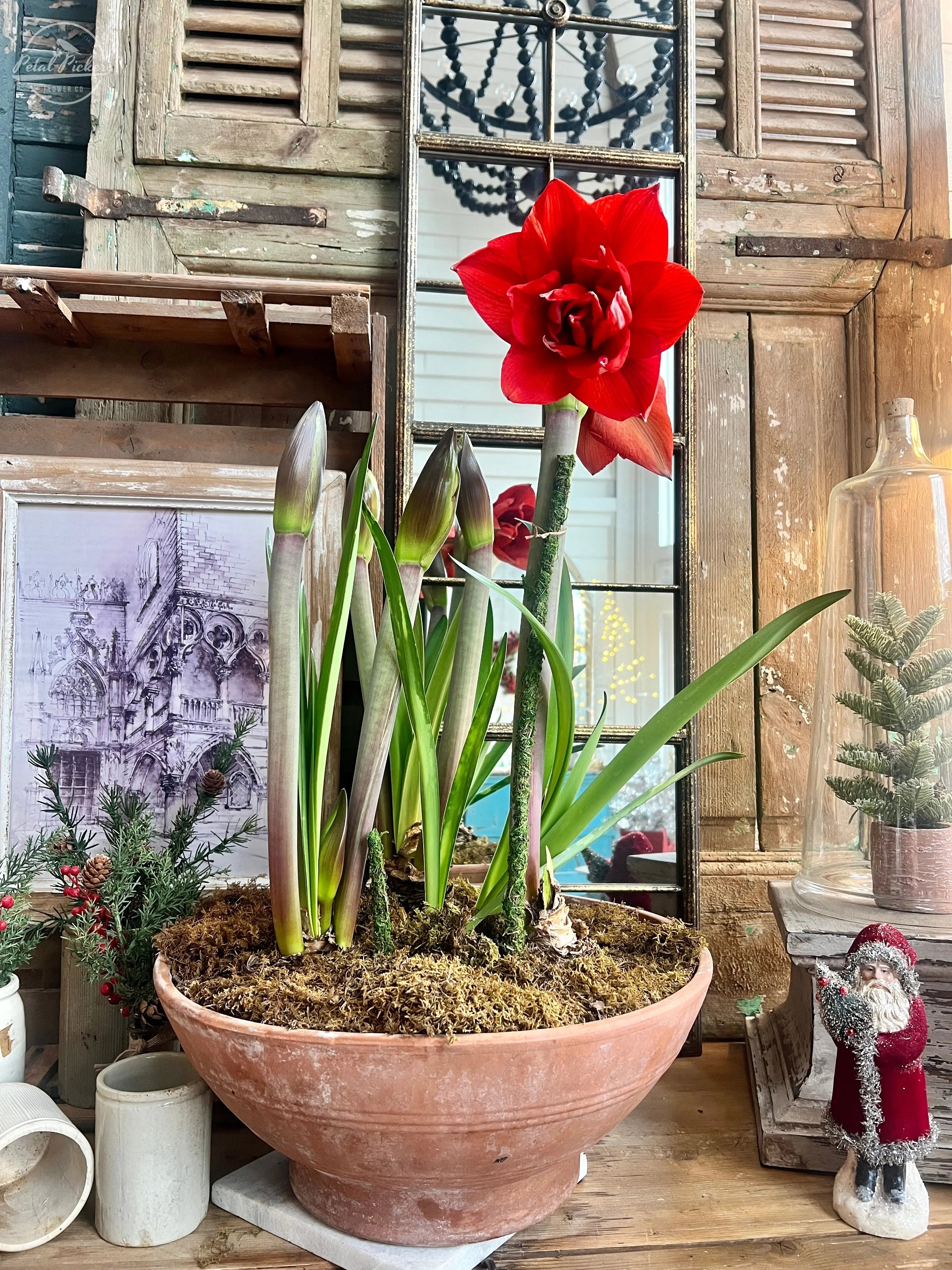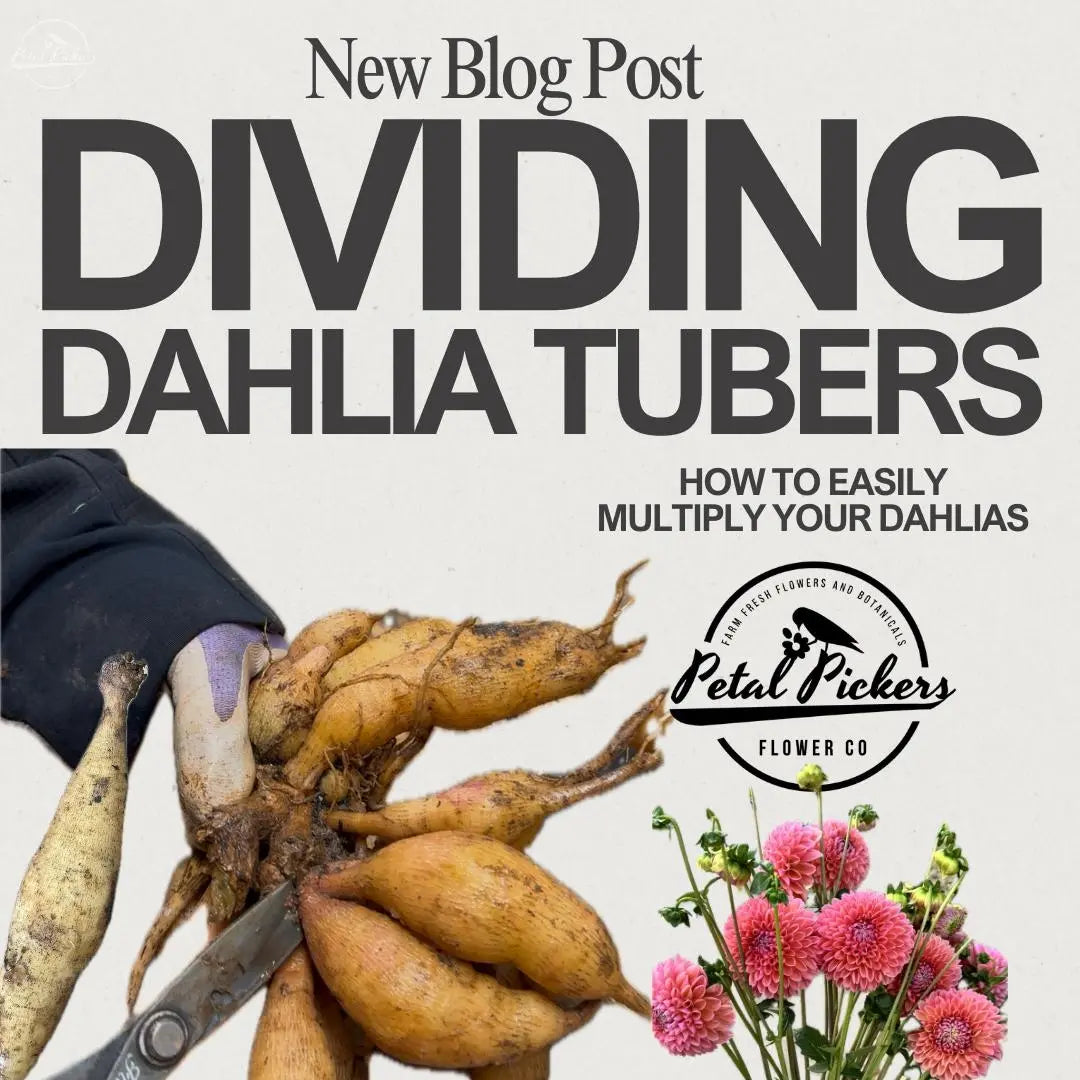Are You Ruining Your Dahlias? Essential Tips for Winter Dahlia Tuber Storage
·

·

Avoid These Common Mistakes When Storing Dahlia Tubers for Winter!
Ah, dahlias — the divas of the flower garden. With their diversity of colors, shapes, and sizes , they’re the showstoppers that turn your backyard into a botanical Broadway. But as much as we adore these showstopping blooms, dahlias need a little pampering when it comes to overwintering their tubers. Trust me, I’ve learned this the hard way (picture me teary-eyed, and throwing out totes of rotten tubers because I thought “Surely, they’ll be fine in the garage!”). Let’s make sure that doesn’t happen to you.
Here are the most common mistakes gardeners make when storing dahlia tubers — and how to avoid them like a true flower farmer.

Why Proper Storage Matters
Dahlia tubers aren’t your average “stick it in the dirt and watch them grow” kind of plants. These beauties need TLC during the colder months. Improper storage can lead to a host of disasters: moldy mush, shriveled necks, or worse, no dahlias left to plant again next year (gasp!).
But don’t worry! Storing tubers isn’t rocket science. It’s more like baking bread — follow the recipe, pay attention to the details, and you’ll be rewarded with something beautiful. Let’s dive in.

The Top 5 Storage Mistakes (And How to Fix Them)
Mistake #1: Skipping the Cleaning Process
Trust me! I get it. After a long season of harvesting, digging, and dividing, the last thing you want to do is spend more time washing tubers. But by removing the clods of dirt caked around your tuber clump, you can more easily check for anything funky going on. This is when we cull any tubers that show signs of leafy gall, crown gall, or symptoms of rot. At our farm, we generally wait to wash off our tuber clumps until we are ready to divide our tubers (usually in January.)
What Goes Wrong: Soil traps moisture and harbors pests, fungi, or bacteria that can ruin your tubers.
What to Do Instead: Wash your tubers gently with water to remove any clumps of dirt. Use a nozzle with a steady stream for stubborn spots. This is the hose nozzle we use Then, let them dry thoroughly, but not much longer than 24 hours. If left to dry too long, the tubers may start to shrivel, and we don’t want that to happen.
Flower Farmer Tip: I like to air-dry mine on a mesh screen in the garage for a day or two. Just don’t forget about them! (Yes, I’ve accidentally turned tubers into crispy chips by leaving them in the sun too long. And winter’s dry air can suck the life out of a tuber fast!) I always consider the relative humidity and check my weather app to plan for my tuber washing days. Rainy or more humid days are the best for washing and drying dahlia tuber clumps.

Mistake #2: Storing Them Before They’re Fully Dry
Imagine sealing wet gym clothes in a plastic bag and leaving it for weeks. Yuck, right? That’s what happens when you store tubers that aren’t completely dry.
What Goes Wrong: Moisture is the enemy. It’ll lead to mold, rot, and heartbreak.
What to Do Instead: After cleaning, let your tubers air-dry in a cool, shaded spot for at least 24-48 hours. Make sure there’s good airflow around them.
Flower Farmer Tip: To test dryness, gently press on the tuber. It should feel firm, not squishy. If it’s still damp, give it more time. If it’s turning soft, you have left it out for too long, and it’s beginning to shrivel. Shriveled tubers doesn’t necessarily mean the tubers won’t grow in Spring, but it’s not the most ideal. We want tubers to still be firm before putting them into storage.

Mistake #3: Using the Wrong Storage Material
Oh, the horror of opening a plastic bag filled with rotting tubers. (Been there, Done that!)
What Goes Wrong: Plastic traps moisture, which can lead to mold and/or rot if not ventilated properly. Too much exposure to dry air, and your dahlia tubers will turn to dust.
What to Do Instead: Opt for breathable storage solutions like paper bags, crates lined with landscape fabric, bins filled with peat moss or vermiculite, or a mix of these options. These materials wick away excess moisture while keeping your tubers snug. Cedar shavings work for some. Not only do they absorb moisture, but they also repel pests.
Flower Farmer Tip: At Petal Pickers we have tried each of these methods. We have learned, it depends on your specific set-up, weather conditions, and storage conditions. If your winter air is exceptionally dry, plastic tote storage may be the best option. Just make sure to peek every few weeks under the lid to check for any mold forming. You can prop open the lid on plastic storage bins for a day or so to allow for fresh air movement, and to release some of the excess moisture pooling under the lid.
*For surface blue molds, simply spray with Lysol.
*For surface blue molds, simply spray with Lysol.
*Adding storage mediums like peat moss, vermiculite, or cedar shavings also creates a barrier between tubers to help prevent the spread of molds/rot.
Mistake #4: Ignoring Temperature and Humidity
Tubers are picky about their winter home. Too warm, and they’ll sprout early. Too cold, and they’ll freeze. Too dry, and they’ll shrivel. It’s like trying to keep Goldilocks happy.
What Goes Wrong: Extremes in temperature or humidity can destroy tubers.
What to Do Instead: Store tubers in a cool (40-50°F), dark place with moderate humidity (about 85%). A basement, unheated garage, or root cellar works well.
Flower Farmer Tip: Use a thermometer and hygrometer to monitor conditions. If it’s too dry, add a bowl of water nearby (not touching the tubers), or a humidifier to the room. Too damp? Move them to a less humid spot.
We store our dahlias in our walk-in coolers with the temperature set at 45°F. We add a simple box fan to increase air movement. Our concrete floors allow moisture from underneath to come into the coolers, and creates an 90% humidity environment. This is great for keeping dahlia tubers firm, but it’s high enough to form mold. To prevent mold from forming, you can dust the tubers with cinnamon, sulfur powder, dip in fungicides, or create a space with slightly lower humidity.

Mistake #5: Forgetting to Label Your Tubers
Come spring, you’ll thank your past self for being organized. Trust me.
What Goes Wrong: Without labels, you’ll end up with a guessing game. Was this the fire engine red bloom or the pastel pink?
What to Do Instead: Use waterproof tags and permanent UV Garden markers to label each variety before storage. Attach the tag securely to the tuber or tie it to the stem remnant.
Flower Farmer Tip: Include notes like bloom size or height. It’ll save you time when planning next year’s garden. That way, when you bring your totes out to plant in the garden or farm, you will easily be able to organize your dahlias how you prefer.
We also make sure to tag every bin or tote twice. We tie flagging tape with the variety name to each crate and include a stake with the variety name inside the crate. We have heard many stories of critters eating flagging tape/labels while in storage over winter.
Bonus Tips for Storing Dahlia Tubers Like a Flower Farmer
Inspect Regularly
Don’t just toss your tubers in storage and forget about them. Check them every few weeks for signs of rot or shriveling. If you spot a problem, remove the affected tuber to prevent it from spreading.
Have a Backup Plan
If you’re anything like me, you’ll have a “just in case” stash of extra tubers stored in a different location. It’s insurance against an unexpected storage disaster.
Experiment with Storage Methods
Not every method works for every gardener. Try peat moss, vermiculite, or even sawdust. Your basement might be too dry, but your garage might be perfect. Trial and error is part of the fun. Just don’t put all of your eggs in the same basket until you have found a method that works great for you.
Common Questions About Storing Dahlia Tubers
Q: Can I store dahlias in my basement?
A: Absolutely! Just make sure the temperature and humidity are within the ideal range (40-50°F and about 85% humidity). If your basement is slightly warmer (ie. 60 degrees) you can still store the dahlias, but they may begin sprouting while in storage. Typically, they can still be planted in spring with success.
A: Absolutely! Just make sure the temperature and humidity are within the ideal range (40-50°F and about 85% humidity). If your basement is slightly warmer (ie. 60 degrees) you can still store the dahlias, but they may begin sprouting while in storage. Typically, they can still be planted in spring with success.
Q: What should I do if my tubers start sprouting early?
A: Move them to a cooler spot or just trim the sprouts before planting in spring.
A: Move them to a cooler spot or just trim the sprouts before planting in spring.
Q: How can I tell if a tuber is still viable?
A: Gently squeeze the tuber. If it feels firm and plump, it’s good to go. If it’s soft, shriveled, or moldy, toss it. Dahlia tubers need to have a firm neck and some crown visible to form an eye to sprout in Spring. If you see an “eye” forming on the tuber crown, this generally means that your tuber is viable.
A: Gently squeeze the tuber. If it feels firm and plump, it’s good to go. If it’s soft, shriveled, or moldy, toss it. Dahlia tubers need to have a firm neck and some crown visible to form an eye to sprout in Spring. If you see an “eye” forming on the tuber crown, this generally means that your tuber is viable.
Conclusion: Follow the Guidelines
Storing dahlia tubers doesn’t have to be a daunting task. With a little attention to detail (and a dash of patience), you’ll wake up your tubers in spring ready to grow into the garden’s star performers.
- Make sure your dahlia tubers are dry before placing into storage.
- Keep them around 40-50 degrees and 85% humidity while storing them.
- DO NOT LET THEM FREEZE or they will instantly turn to mush and die.
We all enjoy a little pampering from time to time. Remember to love on your dahlia tubers in the Winter, so they can grow beautifully next season.




Comments
MARIANNE HURLBURT —
Do all your bulbs and tubers have to be dug up in the fall?
Marianne —
Can any of these bulbs or tubers grow in Zone 10, Naples, FL??
Kevin Kramer —
I’ve got a fridge full of tubers stuffed in a refrigerator. Thanks for sharing your knowledge with all of us!😺 the baking analogy is spot on😃. And vulnerable so pampering/protecting/careful action woulbe key to their survival(and my happiness)